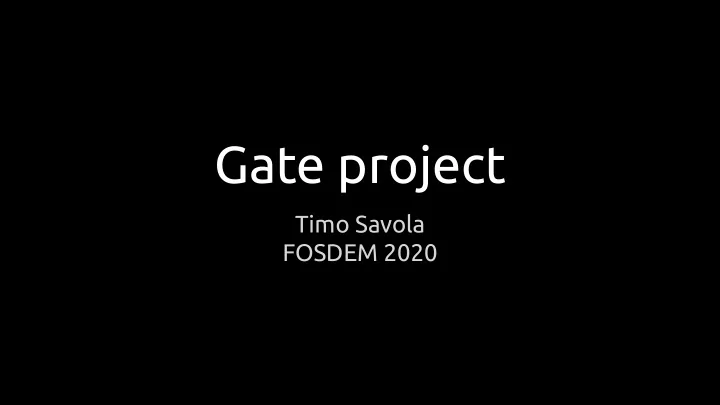

Gate project Timo Savola FOSDEM 2020
Portable execution state Migrate live programs between desktops, servers and devices - safely. Gain control by repositioning the abstraction layer. Distributed software architecture, or dynamic network architecture. Disclaimer: not a blockchain.
Reposition the abstraction layer USER Indirection layer for portable code CODE Traditional indirection layer DATA
Reduce external interface surface Display and input API Format specifications Human interface Data files Application devices Data is portable. Portable code can be bundled with it, dissolving the boundary.
Reposition communication interface for locality Local API Network protocol Server: Server: Client Controller Services API can be moved into the server. Network I/O patterns become a client detail.
Gate Personal hobby research project. In development for 5 years - or over 10 if counting previous experiments. BSD license. https://github.com/tsavola/gate https://gate.computer
Three tiers WebAssembly Portable program format, and a tooling ecosystem to go along with it. Runtime for untrusted code Usual Linux containerization features, but with extreme decoupling. Pluggable, discoverable services Hosts can provide their own sets of APIs.
Portable snapshot and restore No support needed from user programs. A running instance can be suspended at any time. The effect is immediate (or at least the time is bounded). Snapshots are WebAssembly binaries with Gate-specific custom sections. Other runtimes could load them, but they appear as modules without any export functions. Halted instances have returned from their entry function. Such snapshots have export functions, which may be called to re-enter the program.
Internals Go packages, including a WebAssembly compiler: https://github.com/tsavola/wag Runtime core implemented in C and assembly. Implementation is currently Linux-specific. Supports x86-64 and ARM64. Can also run on Android.
Safety WebAssembly defines a logical sandbox. Each program invocation has its own OS process. Service interaction happens via IPC messages sent through pipes. Linux syscalls restricted via seccomp filter: Whitelist: read, write, close, ppoll, mprotect, rt_sigreturn, exit_group. mprotect arguments are restricted. Finally, employ all the Linux namespaces to protect the host system.
Services Services are discovered and may disappear as the program migrates. Implementations: catalog ‒ explore available services. origin ‒ I/O with the originator/owner of the instance (≈ stdio). gate.computer/localhost ‒ access whitelisted HTTP endpoints. ⋯ Services are implemented in Go. State serialization has an important role. Next step: Support communication among peers on a server.
User program APIs Impossible to support standard APIs meaningfully. Limited WASI support; Gate services are accessible through a dedicated file descriptor. No blocking system calls. Purely asynchronous programming model. Primitive C API. Used for simple test programs. Rust is ideal for lightweight WebAssembly programs: Gain crate provided Gate support, but it's out of date. Next step: Update it, with std futures and async/await syntax support.
Demo 1. Start the Gate port of Doom on an x86-64 machine. 2. Suspend it (SIGQUIT). 3. Show stack trace at the suspension point. 4. Create a snapshot. 5. Inspect the snapshot using wasm-objdump. 6. Copy the snapshot to an ARM64 machine. 7. Resume the game from the snapshot. https://github.com/tsavola/doom https://gate.computer/raster
Gate components gate Command-line client for the local daemon and remote servers. gated D-Bus daemon running and managing programs for the local user. gate-server Web server serving the public, or just authenticated users.
Server highlights Can be configured to serve anonymous drive-by execution requests. Uses Ed25519 public keys for grouping persistent resources. Authentication is optional. Supports SSH keys and authorized_keys files. Optional IPFS support for sourcing programs. Remote WebAssembly debugging with breakpoints. Portable snapshots.
Program and instance image management Stored in sparse files; snapshotting requires shared memory mappings. Backends: memfd (or ashmem on Android). Regular files on a filesystem, optimized for zero-copy (reflink). Normally, programs and suspended instances would go on the filesystem, and running instances in memory. But instances can also be directly backed by the filesystem.
WebAssembly “microcode” Additional safety layer. Written in WebAssembly text format for stability. Trusted WebAssembly library between user code and low-level runtime functions (syscall wrappers) implemented in x86-64/ARM64 assembly. Implements the Gate runtime ABI (including WASI). Pointer arguments of ABI functions need to be checked carefully before accessing memory. The low-level functions avoid pointers so that the WebAssembly compiler can generate checked memory access code outside of hand-written assembly code.
gate.computer savo.la
Recommend
More recommend